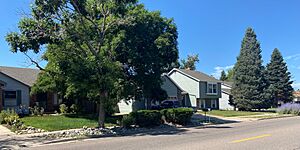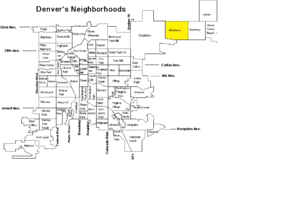Montbello, Denver facts for kids
Montbello is a neighborhood in the city of Denver, Colorado. It's located in the far northeast part of Denver. Its borders are E 56th Avenue to the north, the I-70/I-225 junction to the south, Peoria Street to the west, and Chambers Road to the east.
Quick facts for kids
Montbello
|
|
|---|---|
|
Neighborhood
|
|

Montbello street in summer (2023)
|
|

Map of Denver’s neighborhoods, Montbello is highlighted in yellow.
|
|
| Country | |
| State | |
| City and County | |
| Elevation | 5,295 ft (1,614 m) |
| Population
(2020)
|
|
| • Total | 33,121 |
| ZIP Code |
80238, 80239
|
Montbello is the most populated neighborhood in Denver. It has over 30,000 people living there. There are about 9,000 homes. Even with many people, it's less crowded than some other parts of the city.
Contents
Montbello's History
After World War II, Denver faced a big problem. There weren't enough homes for everyone. Many Black and Hispanic families were only allowed to live in certain areas. This was due to unfair housing rules. Soldiers returning from war also needed places to live.
Leaders in Denver were criticized for not solving this housing problem. Over the next few decades, the city started building new communities. They built them further out from the city center.
The land that became Montbello was once farmland. It was bought in the 1950s. A company called Perl-Mack Construction built the first homes. They wanted these new areas to be "self-sufficient" communities.
Montbello was supposedly named from an Italian phrase. It means "beautiful mountain." This was because of the great views of the Continental Divide. However, some people say the name didn't have a special meaning.
Becoming Part of Denver
Montbello officially became part of Denver in September 1965. The city bought nearly 3,000 acres of land. Building started the next year. City planners made sure there were homes, parks, and schools. They also designed the area for cars.
Homes built in the 1960s and 1970s were often ranch or split-level homes. They usually had brick outside, attached garages, and basements. Later homes were built with more levels. Because there was so much empty land, home building continued until the early 2000s.
Even though there were laws against unfair housing, some real estate agents acted unfairly. They would guide white families away from Montbello. This helped shape the different groups of people who live there today.
Current Challenges
Montbello is in an area that some historians call the "inverted L." This describes how different parts of Denver have different living conditions. Neighborhoods farther from the city center often have lower incomes. They also tend to have fewer white residents and more environmental issues.
Since 2014, Montbello has been called a "food desert." This means there aren't enough full-service grocery stores nearby. Over 33,000 residents are served by only one small grocery store. The closest full-service stores are in other neighborhoods.
In the late 1990s and early 2000s, home prices in Montbello were high. In 2017, a newspaper called Montbello the "nation's hottest suburban housing market." As Denver grows, people in Montbello worry about rising housing costs. They are concerned about being forced to move out.
Education in Montbello
Montbello has several public schools for different age groups.
Public Schools
- Escalante-Biggs Academy (Early Childhood Education to Kindergarten)
- Maxwell Elementary
- Barney Ford Elementary
- Monarch Montessori Of Denver (Public Charter Montessori Kindergarten to 5th grade)
- Oakland Elementary
- John Amesse Elementary
- McGlone Academy (Early Childhood Education to 8th grade)
- Marie L. Greenwood (Kindergarten to 8th grade)
- Farrell B. Howell (Early Childhood Education to 8th grade)
- Montbello High School
The closing of Montbello High School in 2010 caused a lot of debate. Many people in the community felt the school was very important. After it closed, the campus was used by three smaller schools.
After years of hard work by families, teachers, and former students, the Denver Public Schools board voted to reopen Montbello High School. They also approved money for rebuilding the campus. The school welcomed its first returning class in the fall of 2022.
Montbello's Population
According to the 2020 U.S. Census, Montbello had 33,121 people. About 32.9% of the people were under 18 years old.
Here's a look at the different groups of people in Montbello in 2020:
- Hispanic or Latino (of any race): 65.4% (Most of these, 58.5% of the total, were of Mexican background)
- Black or African American: 20.8%
- White (not Hispanic or Latino): 7.4%
- Asian: 1.97%
- American Indian/Alaska Native: 1.13%
- Native Hawaiian/Pacific Islander: 1.17%
- Two or more races (not Hispanic or Latino): 2.46%
In 2020, about 54.8% of people over five years old spoke Spanish at home. Also, about 15.8% of all people in Montbello lived below the poverty line.
Community Groups
Several groups work to improve Montbello:
- Far Northeast Neighbors
- Montbello 20/20
- Montbello Organizing Committee
- Steps to Success
- Montbello Neighborhood Improvement Association
- Struggle of Love Foundation
The Montbello Organizing Committee, or MOC, is a non-profit group. It started in 2013 from local community efforts. Today, they work on problems like rising housing costs and the lack of grocery stores. They also address unemployment and education quality.
Some of their partners include the Colorado Health Foundation and the City of Denver. They want to create more affordable housing. This helps current and new residents stay in the neighborhood.
In 2023, a big project called the Montbello FreshLo hub began. It's an $85 million development led by the community. The FreshLo hub will be at 12444 East Albrook Drive. It will include:
- 97 affordable apartments (1, 2, and 3 bedrooms)
- A Daily Table grocery store
- A cultural arts education center
- Mental health services from WellPower
- Office, retail, and meeting spaces for businesses and non-profits
Famous People from Montbello
- Jon Platt, a music executive, grew up here.
- Joy Reid, a journalist and political commentator, spent part of her childhood here.
- Javon Jackson, a jazz musician, also grew up in Montbello.

